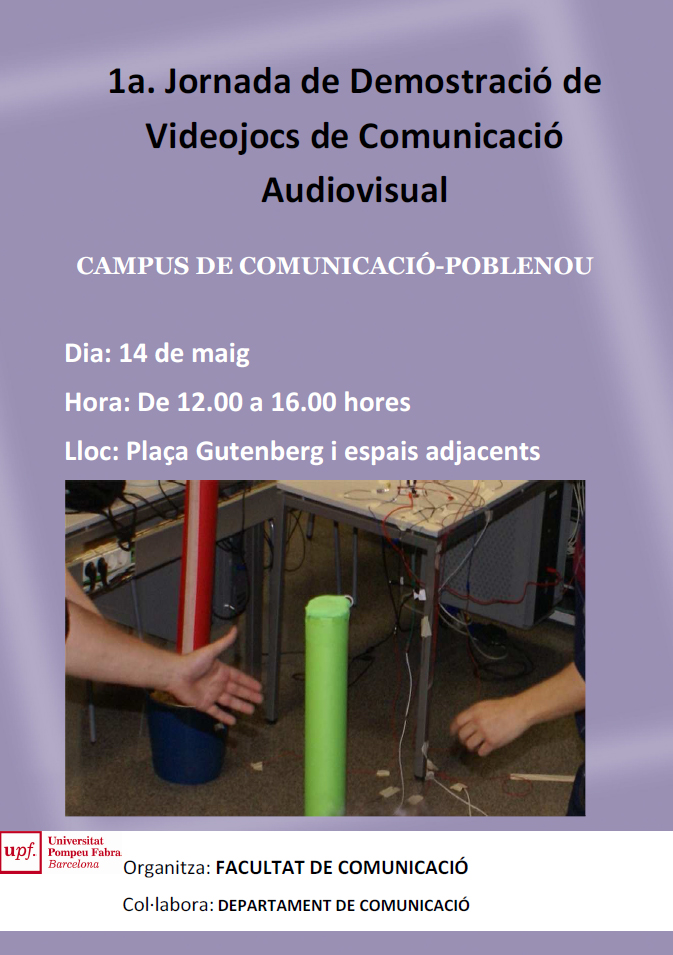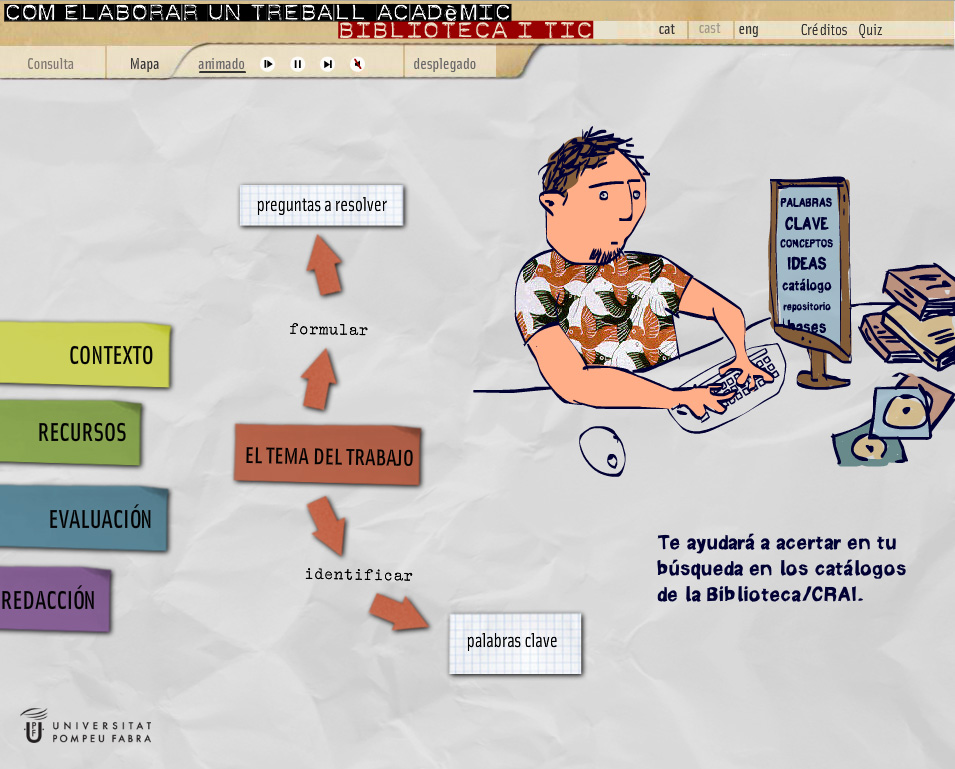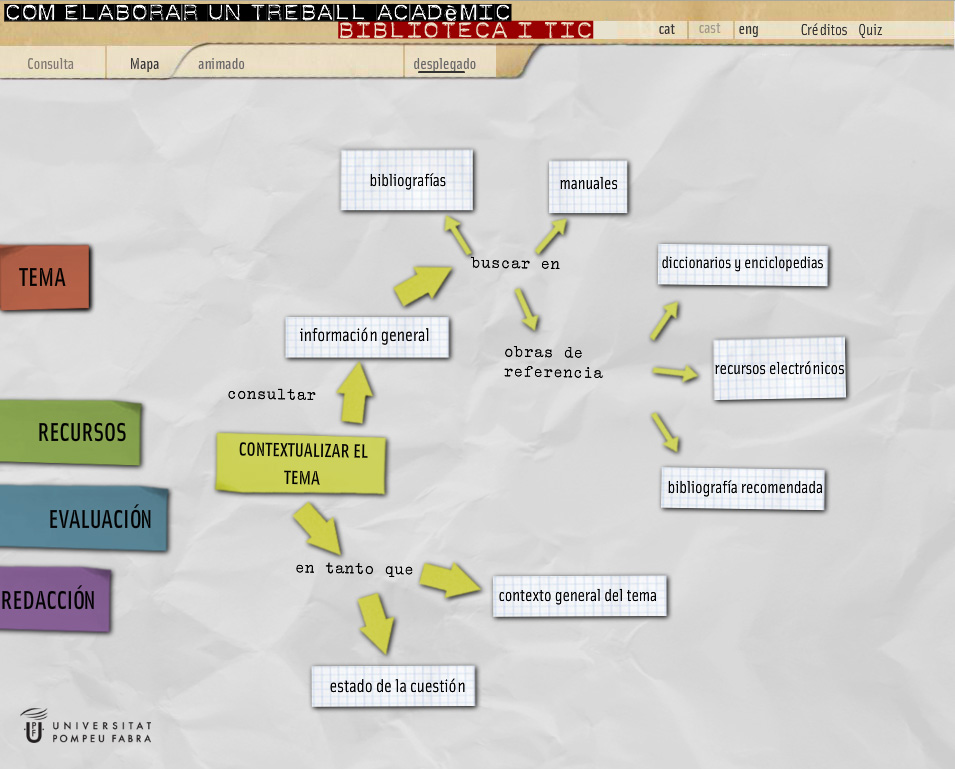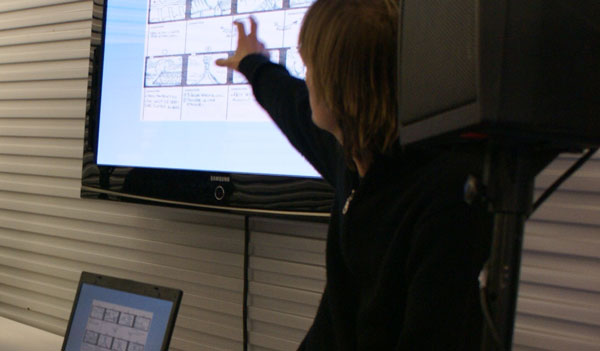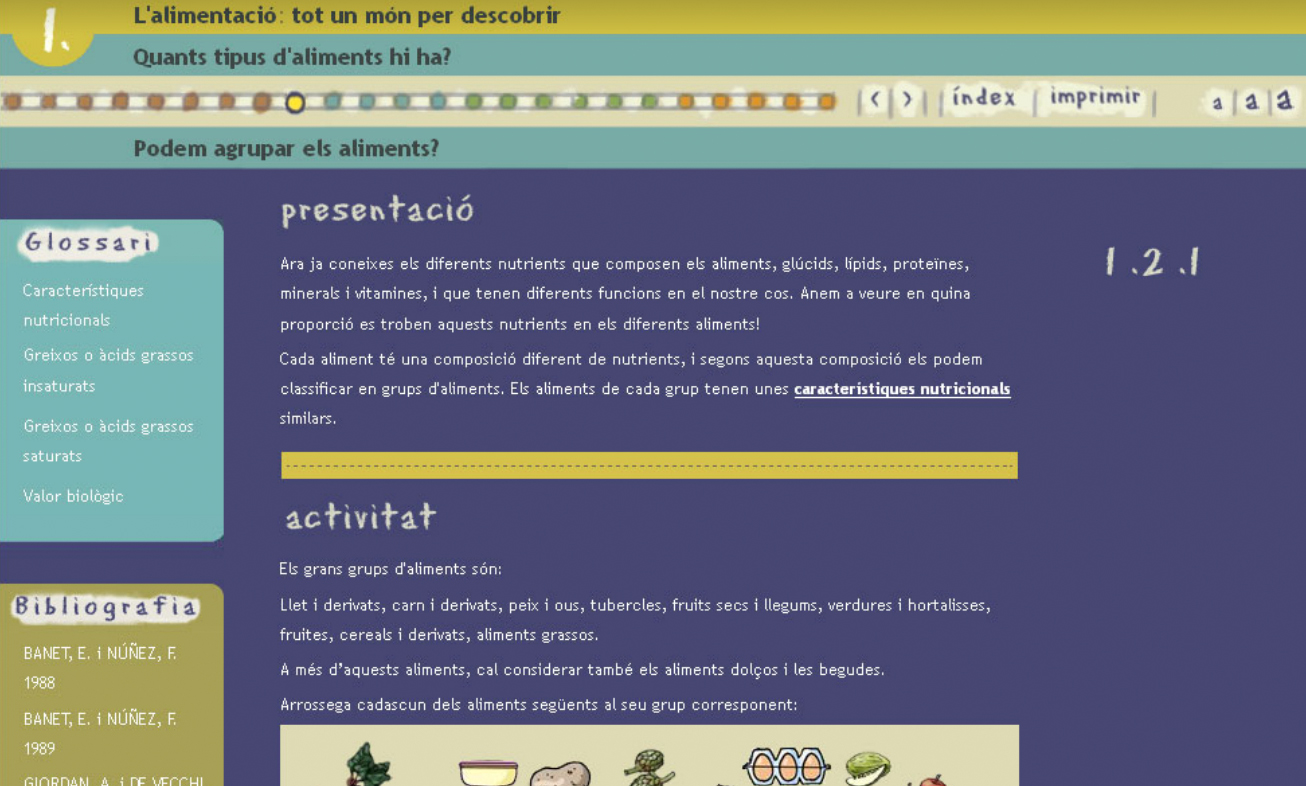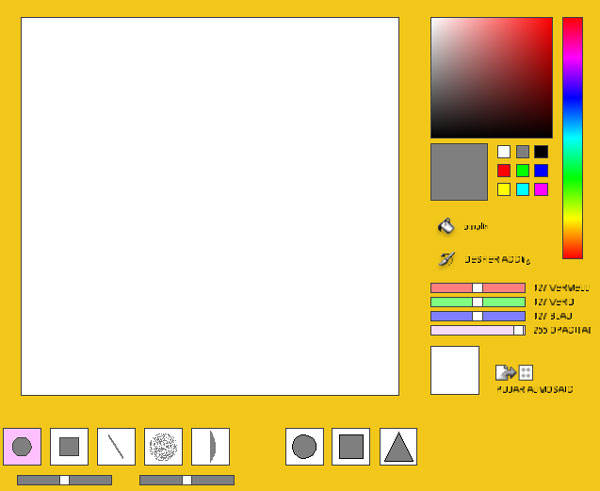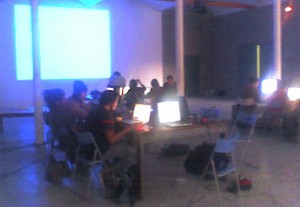Digital Babylon is an interactive installation created in 2005.
An extensive description of the Piece was published in 2011 in the book Impresión Expandida / Expanded Print, published by the Universitat de Barcelona, within the chapter Playing with Pixels. The complete reference and the descriptive text are below.
‘Digital Babylon’ is an Artificial-Life interactive installation in which the visitor’s presence alters the work’s computer generated ecosystem
This piece gives two choices to the visitors: contemplation and interaction. It is a digital ecosystem that works on its own without the need of human intervention. There are two creatures (the triangle beings and the roundheaded tailed predator) and a plant, that interact with each other, eat, kill, die, mate and reproduce. By doing the latter, the two animal’s species evolve.
If the visitor decides to intervene, the action will be done with his/her body, moving around a designated space. When doing so, the visitor’s body’s position will be mapped on the virtual world, and the triangle beings will be more or less attracted to the visitor, depending on how much friendly each one of them is. At this point, the participant decides either to help or to harm the triangle beings. Keeping them away from the predator will be helping them, and dragging them to the predator (to death) will kill some of them and harm the species. Depending on this actions, the next generations (where friendliness is one of many factors that the virtual parents pass on to their children) will be affected, becoming the species as a whole more or less friendly with visitors and, therefore, more or less inclined to interact with the human beings visiting the space.

Some documentation videos:
The ecosystem:
Visitors in the installation:
A simulated visitor:
Evolution: An example of the change for behavior (through evolutionary programming) after a 13 hour run:
Detail: An individual of the main species eating, dying:
Detail: Reproduction in the main species:
Detail: Predators go back to the nest:
Detail: Predators attack:
”
Digital Babylon is an interactive installation that is very different to the previous ones. In the first place, its aesthetic, which abandons work with real images in order to concentrate on synthesised ones. Synthetic and simplistic images, as the elements that make them up are intentionally simple so that movements and interactions can give the piece its intended feeling.
The piece presents the viewer with a small virtual ecosystem. The system works without the need for the viewer’s intervention, although she can actually intervene in order to alter it. by entering a designated space in front of the projection that presents a virtual space. This installation was born out of the will to propose an alternative to a process that was commonly found in interactive installations. That is, one of a clear duality of states: a first state of waiting, always identical, and a second of interaction. Usually, once the second state is over, the piece simply returns to the first state. Digital Babylon proposed to try and make an installation that would accumulate each and every one of the audience’s interactions, to offer a proposal to the viewer that is always changing. The point was to offer the viewer two levels of interaction. A level where one finds and understands immediately, and another, more subtle one, closer to the idea of a piece that converses with its surroundings, that we might call cumulative interaction[1].
The work, inspired by works such as A-Volve by Christa Sommerer and Laurent Mignonneau, or Karl Sims’ Evolved Virtual Creatures, offered a double level of interactivity. One is obvious, with the viewer entering the installation space, and another subtler one of accumulation, developed through evolutionary programming. What follows is a description of the work and its processes.
Upon entering the installation space, the user finds himself before a projection of a black background. Within it, two types of visual elements are moving and a third one gradually appears. They constitute the two species that live within this virtual ecosystem with a third element that they feed on.

Digital Babylon’s Virtual Ecosystem
The first species (which we shall call main species) is made up of between a few and a few hundred of simple looking beings (small triangles that change colour when their state changes). Its basic functions are to feed and breed. If they don’t do the first of these enough, they die. And if they do it up to a certain level, they can accumulate enough energy to attempt the second function. If the attempt proves to be fruitful, a new being of the same species is born and enters the chain. All of this is done whilst avoiding contact with the other species, which is its predator, as much as possible. The second species also has its own different ways of feeding and breeding. It feeds at the expense of the main species, as it is by eating them that it obtains its food.
The main species finds nourishment in plants, which appear where the lifeless body of one of the members from either species lies, as if its body were a fertiliser for the digital land. The predatory species is aware of this, and always moves around the areas populated by plants. If they find a member of the other species on their way, they will attack it to trap it and eat it.
All these rules and interactions between each individual element generate a considerably complex system, which in its own way creates its own balance and rhythm. There are phases where there is a lack of food, which lead to the death of many individuals, which in turn generates a large number of plants, and, consequently, a new phase of abundance.
Within this whole process, one may observe traces of the afore-mentioned concept of emergence, as complexity sometimes appears to go beyond the explanation that comes from the mere analysis of the parts that make up the work, especially if we consider one last aspect that is yet to be explained.
Both species evolve through genetic algorithms. a computer technique that was first described by John Holland in 1975 and then used by artists linked to A-Life Art (art made by generating artificial life systems). These works applied basic ideas of genetic evolution to programming. In short: genetic algorithms usually begin with a population of elements (agents, programming subroutines, etc.) made in an arbitrary way within a number of predefined parameters (the genotype): each of these elements (phenotypes) is then evaluated according to predetermined criteria (fitness); the most successful elements are selected to then create a new generation of the population, which will be evaluated again, and so on. The variables that make up each of the elements act as virtual DNA, which is re-combined in consecutive generations. In this way, new individuals, even if they are not the same as their progenitors, inherit the characteristics that have made them successful. Finally, there is also the possibility of applying mutations. That is to say, to randomly alter one of the variables that conform some of the individuals. This allows for the insertion of new possibilities into the system that are different to predetermined ones, and which, if efficient within the environment they emerge in, will enter the evolutionary process.
All of this is applied to the two species of Digital Babylon. Every time two individuals of the main species mate, a new individual appears, inheriting their abilities. Here, as in other A-Life Art pieces, there isn’t a predetermined fitness criteria, Their success or failure depends on their interactions with the rest of the elements within the virtual ecosystem and, as we shall see, on the viewers’ actions.
With regards to the predatory species, the process is very similar. Although the reproduction process depends on its actions as a group, the result is the same: only individuals who obtain a certain amount of success within the environment will be able to reproduce.
All of this makes up a complex and, at the same time, changing environment. Both species are constantly evolving. When only a certain type of individuals reproduce, the species as a whole gradually changes, and this in turn affects the rival species [2]. If we finally add the audience’s actions to all this, we may come to an understanding of the idea of a double level of interaction. The way this interaction is produced is, simply, through the user’s presence within the installation.
There is no other interface apart from the body of the viewer. His presence within a determined space in front of the screen leads to the appearance of a small dot that represents him within the virtual ecosystem. When this happens, and as long as they are not too busy eating and trying to mate, each of the individuals of the main species will tend to come more or less close to the newcomer, depending on their virtual DNA code. So, some individuals will completely ignore him. and others will follow him everywhere. From this moment onwards, the viewer can decide how to interact with the individuals that follow him. He may decide to help them, or might do the opposite, which means he will put his followers in danger of being eaten by the predators.

A Visitor in Digital Babylo
Depending on what she does, she will make the individuals who are more prone to come close to visitors, or the more unsociable ones, have more or less possibilities of survival (and, therefore, of reproduction and of passing on their characteristics to consecutive generations). He will affect the interactions of future users of the work, making it easier or more difficult to interact with the individuals of this first species, depending on the sum of all the users’ interactions.
It is in this sense that we can talk about a double level of interactivity: first, there is immediate interaction, where elements react to the visitor’s presence; secondly, there is cumulative interaction, which is made up by each and every one of the users, and which makes the piece change a little with everyone, without any of the subsequent interactions having the capacity to eliminate the effects of those which were produced before it.
This double interaction, together with constant change due to genetic algorithms, is Digital Babylon’s main proposition. The point is for the work to modify each of the individuals’ movements; how members of the same species interact, how they interact with those from other species, with the environment, and how those of the main species interact with the user of the piece, as a result of all the different interactions and of evolutionary programming. The intention is that in this way, if the installation is active during a long period of time (various days or weeks), the changes might be substantial enough, for a viewer who might return to perceive the work differently, and find it interesting once again.
——-
Notes:
1. The notion of cumulative interaction is described in more detail in the first article mentioned in Soler-Adillon, Joan (2010). “Emergence and interactivity: A-Life Art as a paradigm for the creation of experiences in interactive communication”. Hipertext.net, 8, http://www.upf.edu/hipertextnet/en/numero-8/a-life_art.html. .
2. The results of these processes can be very surprising. During a particular stage of the process, the Digital Babylon prototype was left working for three hours in a row. After this time had elapsed, whilst in a group, the main species moved and (apparently) acted in a way that was surprising, even for the actual programmer.
”
Soler-Adillon, Joan (2011), “Playing with Pixels”, in Impresión Expandida / Expanded Print, eds. Eloi Puig, Alicia Vela and Antonia Vilà (Barcelona, Universitat de Barcelona, Ministerio de Ciencia e Innovación and European Regional Development Fund, ISBN: 978-84-614-8786-8), 169- 176.
Translation by Alex Reynolds.















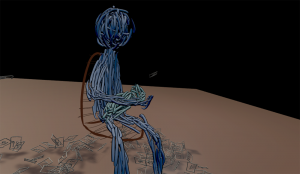
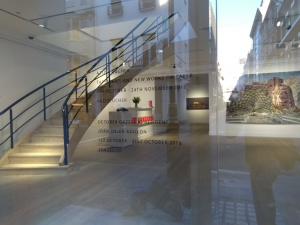





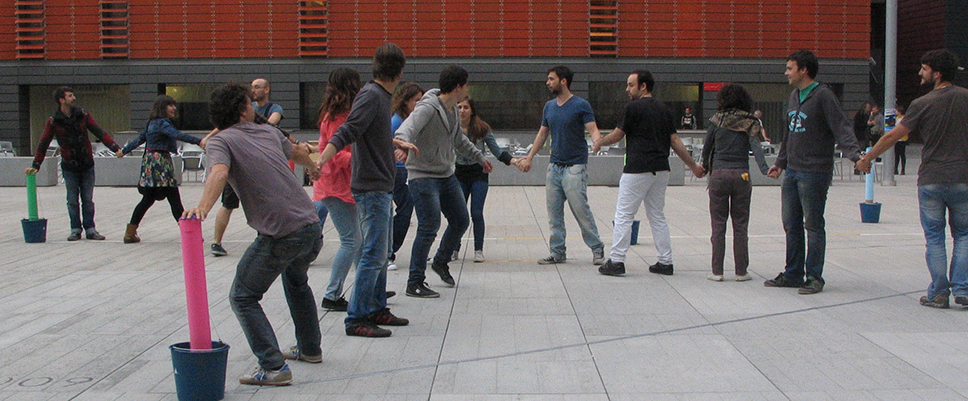 Cadenes humanes at the UPF campus, May 2013
Cadenes humanes at the UPF campus, May 2013

